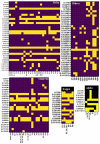Mutation Analysis of SARS-CoV-2 Variants Isolated from Symptomatic Cases from Andhra Pradesh, India
- PMID: 37631999
- PMCID: PMC10458099
- DOI: 10.3390/v15081656
Mutation Analysis of SARS-CoV-2 Variants Isolated from Symptomatic Cases from Andhra Pradesh, India
Abstract
There has been a continuous evolution in the SARS-CoV-2 genome; therefore, it is necessary to monitor the shifts in the SARS-CoV-2 variants. This study aimed to detect various SARS-CoV-2 variants circulating in the state of Andhra Pradesh, India. The study attempted to sequence the complete S-gene of SARS-CoV-2 of 104 clinical samples using Sanger's method to analyze and compare the mutations with the global prevalence. The method standardized in this study was able to amplify the complete length of the S-gene (3822 bp). The resulting nucleotide and amino acid mutations were analyzed and compared with the local and global SARS-CoV-2 databases using Nextclade and GISAID tools. The Delta variant was the most common variant reported in the present study, followed by the Omicron variant. A variant name was not assigned to thirteen samples using the Nextclade tool. There were sixty-nine types of amino acid substitutions reported (excluding private mutations) throughout the spike gene. The T95I mutation was observed predominantly in Delta variants (15/38), followed by Kappa (3/8) and Omicron (1/31). Nearly all Alpha and Omicron lineages had the N501Y substitution; Q493R was observed only in the Omicron lineage; and other mutations (L445, F486, and S494) were not observed in the present study. Most of these mutations found in the Omicron variant are located near the furin cleavage site, which may play a role in the virulence, pathogenicity, and transmission of the virus. Phylogenetic analysis showed that the 104 complete CDS of SARS-CoV-2 belonged to different phylogenetic clades like 20A, 20B, 20I (Alpha), 21A (Delta), 21B (Kappa), 21I (Delta), 21J (Delta), and 21L (Omicron).
Keywords: Andhra Pradesh; India; S-gene sequencing; SARS-CoV-2; amino acid substitutions; circulating clades; mutations.
Conflict of interest statement
The authors declare no conflict of interest.
Figures






References
-
- Why Genomic Sequencing Is Crucial in COVID-19 Response. [(accessed on 29 December 2022)]. Available online: https://www.afro.who.int/news/why-genomic-sequencing-crucial-covid-19-re....
-
- CDC Coronavirus Disease 2019 (COVID-19) [(accessed on 29 December 2022)]; Available online: https://www.cdc.gov/coronavirus/2019-ncov/variants/variant-classificatio....
-
- Tracking SARS-CoV-2 Variants. [(accessed on 30 December 2022)]. Available online: https://www.who.int/activities/tracking-SARS-CoV-2-variants.
Publication types
MeSH terms
Supplementary concepts
LinkOut - more resources
Full Text Sources
Medical
Miscellaneous

